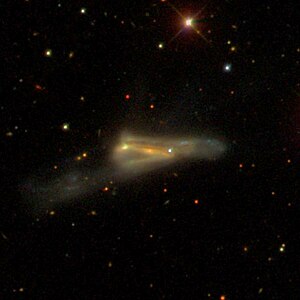NGC 523
| Galaxy NGC 523/537 |
|
|---|---|

|
|
| SDSS recording | |
| AladinLite | |
| Constellation | Andromeda |
|
Position equinox : J2000.0 , epoch : J2000.0 |
|
| Right ascension | 01 h 25 m 20.7 s |
| declination | + 34 ° 01 ′ 30 ″ |
| Appearance | |
| Morphological type | Sbc / P |
| Brightness (visual) | 12.7 mag |
| Brightness (B-band) | 13.5 likes |
| Angular expansion | 2.5 ′ × 0.7 ′ |
| Position angle | 108 ° |
| Surface brightness | 13.2 mag / arcmin² |
| Physical data | |
| Redshift | 0.015871 ± 0.000013 |
| Radial velocity | (4758 ± 4) km / s |
|
Stroke distance v rad / H 0 |
(219 ± 15) x 10 6 ly (67.2 ± 4.7) Mpc |
| history | |
| discovery | William Herschel Heinrich Ludwig d'Arrest |
| Discovery date | September 13, 1784 August 23, 1862 |
| Catalog names | |
| NGC 523/537 • UGC 979 • PGC 5268 • CGCG 521-022 • MCG + 06-04-018 • IRAS 01225 + 3345 • 2MASX J01252074 + 3401305 • Arp 158 • VV 783 • GC 306 • H III 170 • LDCE 0074 NED080 | |
NGC 523 = NGC 537 = Arp 158 is a spiral galaxy in the constellation Andromeda , which is about 219 million light years from the Milky Way . Halton Arp organized his catalog of unusual galaxies into groups according to purely morphological criteria. This galaxy belongs to the class of galaxies with internal absorption .
The galaxy NGC 523 was discovered on September 13, 1784 by the German-British astronomer Friedrich Wilhelm Herschel . Heinrich Ludwig d'Arrest observed the same galaxy on August 23, 1862. However, the double observation was not recognized and so the observation of d'Arrest was given the number NGC 523 and that of Herschel NGC 537.
Web links
literature
- Jeff Kanipe and Dennis Webb: The Arp Atlas of Peculiar Galaxies - A Chronicle and Observer's Guide , Richmond 2006, ISBN 978-0-943396-76-7
